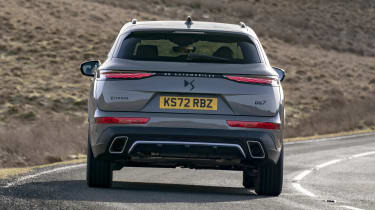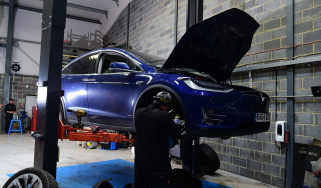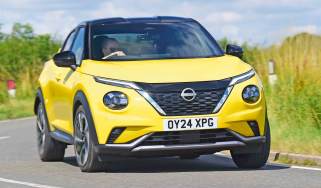DS 7 review - Engines, performance and drive
The DS 7 has low-speed ride quality issues but it’s quiet and comfortable on faster roads. The E-Tense 360 flagship actually handles very well due to its unique suspension settings.

The DS 7 focuses on offering a comfortable drive rather than a particularly thrilling one but it’s only moderately successful in that. The ride can be inconsistent with the car often pitching and bouncing over imperfections in the road surface – struggling to settle.
Like many rivals, the DS 7 comes with a number of driving modes and the default mode is ‘Normal’. But if you want the Active Scan Suspension fitted on the plug-in hybrid models to actually do its thing, you’ll have to jab the diamond-shaped drive mode selector switch and change to ‘Comfort’. Do this and the DS 7 becomes far more comfortable (as you’d expect) – the camera does a good job of scanning the road and tweaking the damping at road speeds of around 30-40mph, but the low speed ride remains noticeably inconsistent and picks up judders too frequently. It can feel a little wallowy at speed on motorways, too.
Flicking the car into Sport mode reveals that the DS 7 isn’t an SUV prepared to be driven swiftly, with sub-par body control and light, lifeless steering. The artificial engine sound actuation induced in Sport mode will quickly get on your nerves but all DS 7 models are otherwise well soundproofed against wind and road noise.
Used - available now

2023 Skoda
Kamiq
31,721 milesAutomaticPetrol1.0L
Cash £14,149
2023 Peugeot
208
14,029 milesAutomaticPetrol1.2L
Cash £15,140
2017 Honda
HR-V Hybrid
51,852 milesManualDiesel1.6L
Cash £12,339
2019 Vauxhall
Grandland X
71,771 milesManualPetrol1.2L
Cash £8,745There is an exception to all this, however, because the E-Tense 360 flagship model gets a different chassis configuration tuned by DS Performance. Revised springs and dampers plus a wider track really do make a big difference to the way the DS 7 drives. There are still some question marks over the low speed ride, which can partly be attributed to the standard 21-inch wheels on this version, but things get a lot better as speeds rise. In this specification the DS 7 resists body roll far more effectively and gains a much more nimble feel. It’s a shame that similar tweaks couldn’t have been made across the range. The steering is heavier as well, but still lacks any feedback.
0-62mph acceleration and top speed
These days, DS 7 buyers can either choose diesel or an E-Tense petrol plug-in hybrid. The oil-burner, predictably, is the budget option – it's a 1.5-litre, 129bhp unit that delivers 300Nm of torque at 1,750rpm. Powering the front wheels and paired with the EAT8 automatic gearbox, it can cover the 0-62mph sprint in 10.7 seconds and the top speed is 121mph. It doesn’t do too badly for refinement, settling nicely while cruising, but unfortunately revealing a trademark, coarse diesel growl when pushed.
The main focus of the DS 7 range is on plug-in hybrid power with the same E-Tense system available in 225, 300 and 360 forms. Power outputs are 222bhp, 292bhp and 350bhp respectively. While the E-tense 225 is front-wheel drive and delivers a maximum torque output of 360Nm, the 300 and 360 models are both all-wheel drive with a more muscular 520Nm on tap. We’ve spent a lot of time testing both the 225 and the 360 versions in the UK and in Europe.
The 225 model is going to feel fast enough for most requirements and it’s doubtful that many of the DS 7’s target market will be particularly desperate to have four driven wheels – this is definitely no off-roader. It can cover the 0-62mph sprint in 8.9 seconds before going on to a 140mph top speed. The gearbox shifts smoothly but there are moments of indecision when the system switches between power sources. Generally, performance feels stronger than the numbers suggest from low speeds thanks to the electrical assistance.
That said, the E-tense 300 is notably quicker, recording 5.9 seconds for 0 to 62mph and a 146mph maximum. It’s just as hushed when cruising but also has the same tendency to sound strained at the top of the rev range, something that’s exacerbated by the over-eagerness the gearbox shows to change down in response to even moderate throttle inputs.
The E-Tense 360 has more power thanks mainly to software changes but the top speed and acceleration numbers are the same. The big differences are the suspension tweaks and bigger brakes you get on this model. If you want the best DS 7 to drive this is it but we suspect the 225 E-Tense or even the diesel are the best fit for most buyers.










